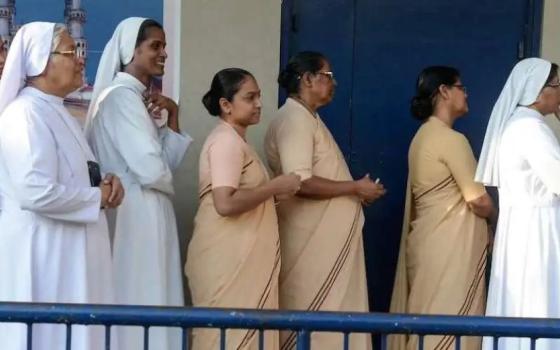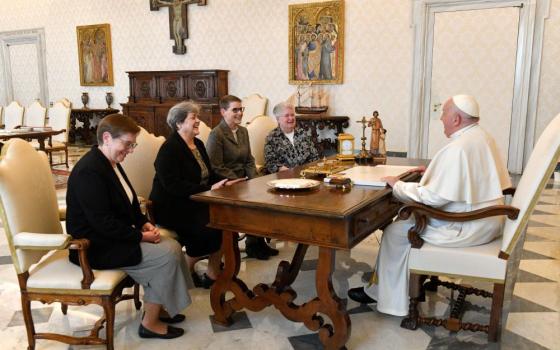
(Pixabay/WOKANDAPIX)
All women religious have reason to rejoice in the publication of The Habit of Poetry, which places Catholic colleges for women and their religious teachers and administrators at the forefront of burgeoning Catholic poetic literature in the mid-20th century. The author, Nick Ripatrazone, highlights the poetry of Catholic nuns who were teachers and administrators, and the prize-winning poetry of their students. I was delighted (but not surprised) to find Sr. Maura Eichner, my teacher at the then-College of Notre Dame of Maryland, (now Notre Dame of Maryland University), among the six poets chosen as exemplars.
I took the long road through college. After my profession as a School Sister of Notre Dame, I became both a full-time teacher and a part-time college student. I majored in English and studied in the summers and, at times, on Saturdays. I plotted to get Sister Maura as my teacher for almost every English course in my program. She taught me from 1950 to 1965. She gifted me with knowledge, love for language and inspiration.
Ripatrazone titled his chapter on my teacher "Sister Maura Eichner, Kenotic Teacher." He details her biography and explores her poetry, lauding her power with words and using numerous passages of her poetry to illustrate the variety of her talents. He marvels at the breadth of her subject matter. He explores the design of her poetry with telling snippets from many poems.
I read this chapter with deep joy. Then I pondered its title: "Kenotic Teacher." I knew the noun "kenosis" from theology: a self-emptying, originally used to describe Jesus' giving up all the powers of divinity to become a human being. But using the adjective “kenotic” to describe the kind of teacher that Sister Maura was?
Advertisement
Almost instinctively, I said "yes." I thought about some special experiences in Sister Maura’s classes. She gave herself fully, usually in a wry way. I remember the first paper that I wrote for her English 101 class. She taught us John Keats' poem, "Ode on a Grecian Urn." Then she asked us to write an essay on one experience in our life that we would choose to "cut on a Grecian urn" as a never-to-be-forgotten moment.
A special scene came to me immediately. I was teaching first grade in South Carolina and attending college in the summer. In my first class was Emily, a child who constantly held her arm up horizontally, covering most of her face. Her mother mouthed the words, "very shy," as she brought her daughter into my classroom. For the next six weeks, no one saw Emily's face. I ignored the arm and, with my eyes, warned the children to do the same. Although I tried in many ways, I could not engage Emily. She never spoke.
One day I was "selling" balloons that I had drawn on the blackboard and colored with bright chalk. Each balloon had a word printed on it. A child who knew the word and could put the word in a sentence could buy the balloon. Hands were waving, and, one by one, the children came to the blackboard to say the word and use it in a sentence. Then, I would ceremoniously take the imaginary string and hand it to the child, while I erased it and the balloon. The child returned with a tightly-held string, smiling. Children love make-believe.
One balloon remained. Amid waving hands, I noticed Emily straining forward in her seat, as if she wanted to get up. "Emily, do you want this balloon?" The room grew still. "It is for you. Come and get it!" Slowly, she slid out of her seat, using both hands. She walked unsteadily down the aisle and said in a low but clear voice, "Mailman. The mailman has a letter for me." A breakthrough!
I labored over the essay, trying to catch a miracle in words. I handed it in, and it was returned in the next class, as all assignments were. On the top of the paper, Sister Maura had written one sentence of appreciation that took my breath away. At the end of the paper, she wrote this sentence. "The double dash is an effective punctuation mark when used with discretion." Oh? I looked back over the essay and realized that I had sprinkled about 15 dashes throughout.
No red circles around each one. Just that sentence. Kenotic, yes. No wielding the red pen like a sword. No superior attitude. Just appreciation and an instructive comment. The light touch. It would teach and not embarrass.
Some years later, still studying, I began teaching seventh and eighth grade in an elementary school in a Baltimore suburb. I was astonished when, one day as school was about to begin, Sister Maura called me on the phone. She explained that she would be teaching the senior seminar, a capstone course, the following summer. In order to take it, I had to have finished the reading list course, but that course would not be taught that year. However, she told me, I could take an independent study course with her for two semesters to fulfill this requirement and finish my degree.
"Oh yes," I replied. "That would be great! Please send me the reading list." An awkward silence followed. Then she gently suggested, "Perhaps you should ask your superior for permission." It was a gentle reminder about protocol. She was thinking only of me, not herself, even though she would have an additional course to tuck into her schedule that year.
I did take the seminar the following summer, along with seven other students. One was an older woman trying to finish her degree. It soon became clear that she had fallen behind. She tried hard to keep up with the seminar conversation as we sat around a conference table, posing and answering questions. We, students, tried not to look bored when she spoke in long, rambling sentences with no logic and minimal content. But not Sister Maura. She never took her eyes away when this student was speaking. She gave her complete attention, and she managed to say something gracious in response. I never forgot this weekly scene.
Many years later, when Maura and I had become colleagues and friends, I asked her how she managed to fix her attention so totally and listen so intently. "I was counting her gray hairs," she said. So honest. So real. So kenotic.
Editor's note: Part of this column previously appeared in an essay by Kathleen Feeley, published on the School Sisters of Notre Dame Atlantic-Midwest Province website.



